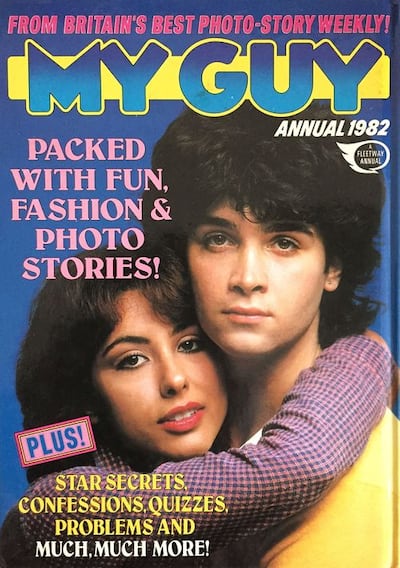There I was recently, passing through a town in Northern Ireland that had a remarkable number of charity shops. I love a good browse among the donated items from other people's households, so browsing I went. The particular shop I was in was empty, apart from myself and the member of staff, who was folding clothes behind the counter.
Among the books stacked higgledy-piggledy on a table in the middle of the room was a true relic from a past era. It was the 1982 My Guy annual.
My Guy was a weekly magazine that featured quite startling photo stories, using real people in the images. They were in black and white, and the stories were always about some facet of a girl and a boy’s relationship, lack of relationship, or hope for a relationship with each other. The text was in speech bubbles. It was pioneering stuff at the time.

As teenagers we passed My Guy around in class and laughed at the clothes, the hair, the awkward poses, the general state of the whole ridiculous thing. We still devoured them, though.
Brianna Parkins: Stop telling me ‘it’s okay to not be okay.’ I want to be okay, thanks
Abdelaziz Bouteflika obituary: President of Algeria for nearly 20 years
Katie Kahn-Carl obituary: Determined editor who established RTÉ’s foreign coverage
Mervyn Taylor obituary: Empathetic Dublin Jew who pushed minority rights
In the charity shop I leafed through the My Guy annual, marvelling at the shockingly bad production values. One photo story was called Free as a Bird. It was about a girl with no ties, who hitch-hikes everywhere with her caged parrot, named Fred, whose only avian words were “Not ’arf.”
In this story she and Fred hitch-hike to London with the guy who picks her up in his car. She ends up crashing at his place, to the displeasure of his girlfriend, who thinks the lad is falling in love with parrot lady, steals cash from his wallet, puts it on a horse, wins big, and then vanishes with Fred the parrot again. You’d have to wonder if the writers who came up with these storylines were permanently stoned.
I leafed on. There were guides “to make a date great” and “ways to make you a hit with a fella”. The advice?
- "Never run your fingers through his hair without invitation. The spray-on colour could come off on your hands."
- "Send him a threatening note. Say you'll kill him if he doesn't notice you soon."
There was, of course, a Problem Page, with Agony Aunt Chris. “I don’t understand my boyfriend,” went one letter. “Most of the time he’s lovely to me, but then he goes all funny. He won’t speak to me and he doesn’t bother to ring me up. It hurts me so much when he’s like this. Why is he?”
This was a September afternoon in 2021, when one distressed woman in charge of her shop was asking another woman, her sole customer, for a response to her heartbreaking question
I was just reading Chris’s answer – “He’s immature and that’s why his behaviour is so erratic” – when the woman who worked in the shop approached me. Engrossed as I was in Chris’s Problem Page, it took me a few seconds to realise she was standing right beside me. “Lovely day,” I said inanely, to be polite. I wondered was she going to tell me off for spending so long reading the book. I got ready to explain I was going to buy it.
This is what she said to me: “What would you do if your husband left you for another woman, and they went off and had a baby together, even though he’d never wanted to have a baby with you, and then you had to watch them every day going round the town you live in? What would you do?”
She stared at me. I was completely taken aback.
“What would you do?” she repeated, flatly.
I found myself stupidly wondering what Chris would have said to her, although I doubt Chris got those kind of letters. But this wasn’t a relationship problem in a 39-year-old annual for teenage girls. This was a September afternoon in 2021, when one distressed woman in charge of her shop was asking another woman, her sole customer, for a response to her heartbreaking question.
“I’m sorry,” is what I said.
“He ruined my life. I met him when I was 20. We were together 17 years.”
“I’m sorry.” I wondered if she disclosed this terrible story to many of her customers. Or if something had happened to make her feel she had to, right this moment, share this information with a stranger. I closed my My Guy Annual 1982 and tried to think of something appropriate to say to acknowledge her dreadful story.
It is, I think, our business to try to be kind, to be compassionate, when we see people in pain, no matter how bizarre the circumstances
“Don’t let what happened steal any more of your life.”
“Every day,” she said bitterly. “I see them together every day.”
“Would you think about talking to someone? A therapist?”
Surely she had thought of this. Or surely one of her friends had. Was she well enough to be working, I wondered. Was it any of my business?
But it is, I think, our business to try to be kind, to be compassionate, when we see people in pain, no matter how bizarre the circumstances. So I stood there for 10 minutes among the second-hand clothes and bric-a-brac and vintage annuals and talked to this woman whom I did not know about her ruined marriage and what she might do.
At the end she leaned in over the My Guy annual that lay between us, grasped my hand, shook it and said, “Thank you”.
Then she went back to the counter and silently resumed her work of neatly, and carefully, folding clothes.















